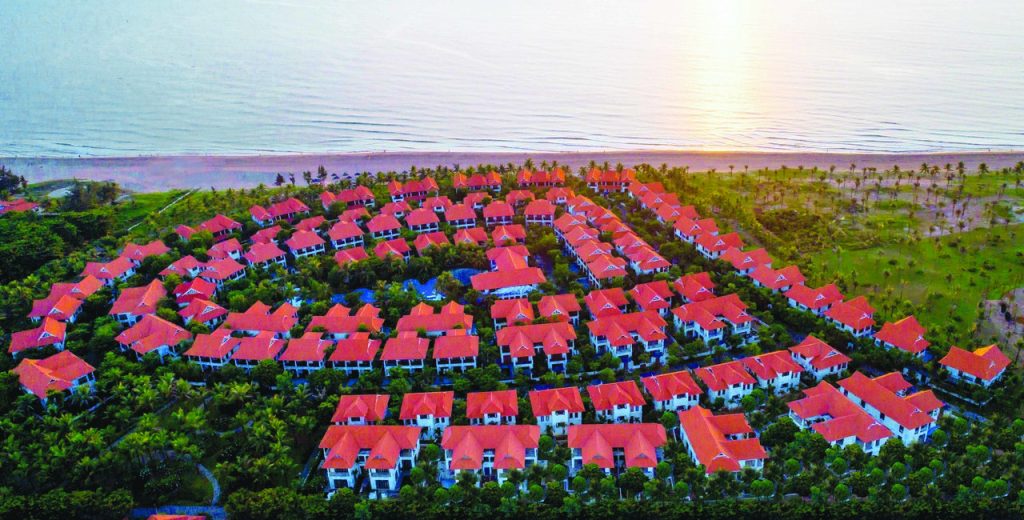So, you’re dreaming of Vietnam, and the stunning journey between Da Nang and Hue is calling your name? Smart choice! Winding along the coast, climbing the legendary Hai Van Pass, the train ride between these two central Vietnamese gems isn’t just transport; it’s an experience, a rolling movie screen showcasing some of the country’s most breathtaking scenery. But wait, you’ve heard whispers – are there *two* different trains? Which one’s the “right” one? Relax, you’ve landed in the right place! As fellow travel enthusiasts here at Tuan Travel, we understand navigating transport options in a new country can feel like deciphering ancient scrolls. That’s why we’ve put together this comprehensive guide.
Consider this your ultimate resource for conquering the Da Nang to Hue railway. We’re diving deep into *both* main options: the swanky new “Connecting Central Heritage” tourist train and the classic, workhorse Reunification Express trains. We’ll break down everything – schedules (the latest we can find, but always double-check!), ticket prices (realistic ranges!), how to actually *book* those coveted seats without pulling your hair out, what the ride *feels* like, and plenty of insider tips gleaned from countless journeys. Our goal? To give you all the info you need to pick the perfect train for your adventure, ensuring a smooth, enjoyable, and unforgettable trip. We’re committed to providing reliable, up-to-date information (hello, 2024/2025!), so let’s get those wheels turning!
Da Nang to Hue Train Options: Quick Comparison
Alright, before we plunge into the nitty-gritty details, let’s get a bird’s-eye view. Choosing between the dedicated tourist train and the regular North-South trains can seem confusing, but it often boils down to your priorities: budget, comfort, schedule flexibility, or the overall ‘vibe’ you’re after. This little table should help you quickly see the key differences:
| Feature | “Connecting Central Heritage” Tourist Train (HD1/2/3/4) | Regular Reunification Express (SE/TN Trains) |
| Target Traveler | Tourists prioritizing comfort, scenic experience, dedicated service. Less budget-sensitive. | Budget travelers, those needing flexible schedules, backpackers, locals, long-distance travelers. |
| Price Range (Approx. One-Way) | ~150,000+ VND (Subject to change – Verify!) | ~70,000 – 120,000+ VND (Soft Seat – Varies by train/time – Verify!) Sleepers more expensive. |
| Duration (Approx.) | ~3 – 3.5 hours | ~2.5 – 3.5 hours (Varies slightly by specific train) |
| Schedule Frequency | Specific, limited tourist-focused departures (e.g., 2 per day each way). | Multiple departures daily (part of main North-South line). |
| Comfort & Amenities | Higher standard: Modern carriages, A/C, comfy seats, large windows, often snacks/drinks included, potentially onboard activities. | Variable: A/C soft seats generally decent. Hard seats basic. Sleepers available. Amenities simpler (basic toilets, food cart). Cleanliness can vary. |
| Scenery Focus | Explicit: Timed and designed to maximize enjoyment of Hai Van Pass views. | Incidental: Follows the same scenic route, but not the primary focus. Views depend on seat/window. |
| Booking | Official VNR site (dsvn.vn), Station, OTAs (Baolau, 12go), Local Agencies. Can sell out faster. | Official VNR site (dsvn.vn), Station, OTAs (Baolau, 12go), Local Agencies. More availability generally, but advance booking still advised. |
Option 1: The “Connecting Central Heritage” Tourist Train
This is the new kid on the block, launched specifically to cater to tourists wanting a more curated, comfortable, and scenic journey between Da Nang and Hue. Think of it as the express route to those jaw-dropping Hai Van Pass views, wrapped in a bit more comfort.
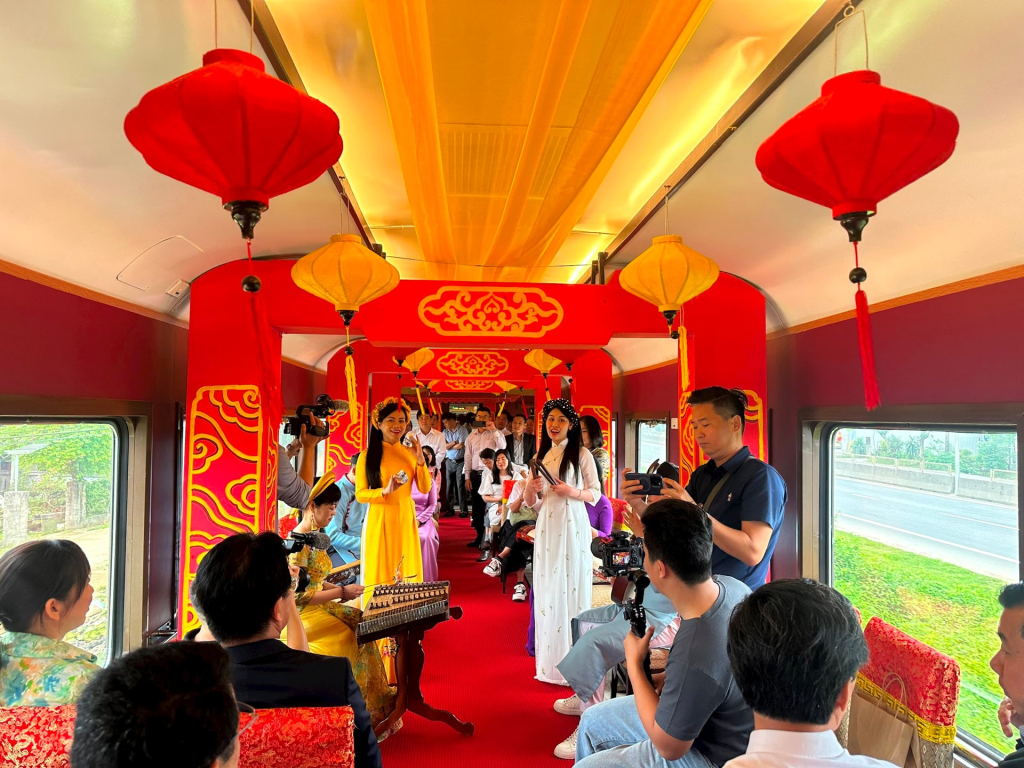
What is the Tourist Train?
Officially dubbed the “Connecting Central Heritage” train (Chuyến tàu Kết nối Di sản), this service is operated by Vietnam Railways (VNR) in collaboration with local tourism authorities. Its sole purpose is to provide a dedicated, high-quality travel experience focusing squarely on the stunning natural beauty between Da Nang and Hue. It uses modern, refurbished carriages designed with travelers in mind – think bigger windows, comfier seats, and often, little extras. If you’re someone who values a guaranteed comfortable seat, air conditioning that works reliably, and an atmosphere geared towards enjoying the ride itself, this train is likely speaking your language.
Tourist Train Schedule & Duration
Okay, let’s talk timings. One thing about dedicated tourist services is that they usually run on a more limited schedule than the regular workhorse trains. As of our last update (and remember, things can change!), the typical schedule looks something like this:
- Da Nang to Hue Train:
- Train HD1: Departs Da Nang around 7:50 AM, Arrives Hue around 11:05 AM
- Train HD3: Departs Da Nang around 3:00 PM (15:00), Arrives Hue around 5:45 PM (17:45)
- Hue to Da Nang Train:
- Train HD2: Departs Hue around 7:45 AM, Arrives Da Nang around 10:35 AM
- Train HD4: Departs Hue around 2:25 PM (14:25), Arrives Da Nang around 5:10 PM (17:10)
The journey duration clocks in at roughly 3 to 3.5 hours. Now, **super important disclaimer:** While we strive for accuracy, train schedules in Vietnam *can* be adjusted. **ALWAYS, ALWAYS double-check the latest official schedule** directly on the Vietnam Railways website (dsvn.vn) or with your booking agent before making firm plans. Think of the times above as a solid starting point, but verify! Trust us, it saves potential headaches later.
Onboard Experience & Amenities
So, what’s it actually *like* riding the Heritage train? Picture this: you step aboard into a clean, brightly lit carriage. The air conditioning is humming pleasantly, a welcome relief from the Vietnamese heat. You find your reserved seat – likely a comfortable, cushioned seat with decent legroom, oriented towards a large, clean window perfect for soaking in the views.

Compared to the regular trains, the vibe is distinctly more tourist-oriented and relaxed. Here’s what you can typically expect:
- Seating: Comfortable, air-conditioned soft seats are the standard. The layout is usually designed to maximize window access.
- Views: This is the train’s raison d’être! The schedule is often timed to ensure daylight passage through the Hai Van Pass. Windows are generally kept cleaner than on regular trains. Pro Tip: For Da Nang to Hue, the **left side** offers the best coastal views as you climb the pass. For Hue to Da Nang, grab a seat on the **right side**.
- Amenities: Expect relatively clean Western-style toilets. Power outlets for charging devices are usually available, though maybe not at every single seat. Wi-Fi might be advertised, but Vietnamese train Wi-Fi is notoriously fickle – don’t count on it for anything critical.
- Food & Drink: Often, the ticket price includes a small complimentary bottle of water and maybe a light snack. There’s usually a trolley service selling additional drinks, coffee, instant noodles, and packaged snacks. Some services might feature kiosks selling local specialties or souvenirs.
- Entertainment: Sometimes, especially during launch periods or special occasions, there might be light cultural performances (like traditional music) in a designated community carriage or announcements pointing out landmarks. Don’t expect a full show, but it adds a nice touch.
- Atmosphere: Generally quieter and more relaxed than regular trains, filled mostly with fellow travelers eager to enjoy the scenery.
Essentially, it’s designed to be a pleasant, hassle-free way to enjoy the journey as part of your vacation, not just a way to get from A to B.
How to Book Tourist Train Tickets
Alright, you’re sold on the Heritage train experience! How do you lock down those tickets? You’ve got a few good options, each with pros and cons:
- Official Vietnam Railways Website (dsvn.vn):
- Pros: Direct booking, official source, no extra agent fees. You can often select your exact seat from a map.
- Cons: The website can be a bit clunky, especially the English translation. Payment sometimes requires a Vietnamese bank card or can be finicky with international cards (though it has improved). You’ll need to register an account.
- Tip: Use Google Chrome for auto-translation if needed. Be patient during the booking process. Look specifically for the train codes HD1, HD2, HD3, or HD4.
- At the Train Station (Da Nang or Hue):
- Pros: Direct purchase, pay with cash or card (usually), can ask questions (if staff speak English or you have a translation app).
- Cons: Requires physically going to the station, potential queues, tickets might be sold out if booking last minute, especially for this popular tourist train.
- Tip: Write down your desired train (e.g., “HD1 Da Nang to Hue”), date, and number of tickets clearly to avoid miscommunication.
- Reputable Online Travel Agencies (OTAs):
- Examples: Baolau.com, 12go.asia are popular choices specifically for transport in Southeast Asia.
- Pros: User-friendly interfaces (often better than dsvn.vn), clear English, usually accept international payment methods easily, offer customer support.
- Cons: Charge a small booking fee/markup on top of the ticket price. Seat selection might be less specific (request only).
- Tip: Compare fees between different OTAs. They email you an e-ticket which you typically show on your phone.
- Local Travel Agencies / Hotels:
- Pros: Convenient if you’re already booking other services. They handle the booking process for you.
- Cons: Will definitely include a service fee. Less control over seat selection. Reliability depends on the agency.
- Tip: Good option if you prefer face-to-face service or find online booking too daunting.
Option 2: Regular Reunification Express Trains
Now, let’s talk about the backbone of the Vietnamese railway system: the Reunification Express trains. These are the regular North-South trains (often designated SE or TN) that connect Hanoi all the way down to Ho Chi Minh City, making crucial stops in cities like Hue and Da Nang along the way. They offer a different kind of experience – perhaps less polished, but often more flexible and budget-friendly.
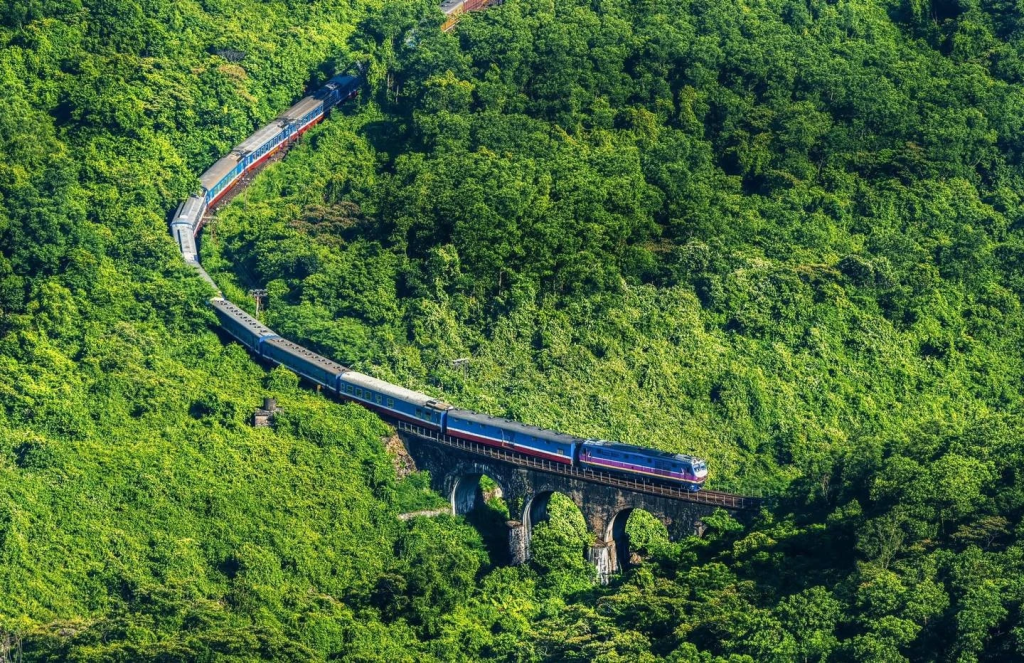
What are the Regular Trains?
These trains are the workhorses, carrying a mix of locals commuting, families visiting relatives, backpackers traversing the country, and yes, tourists doing the Da Nang-Hue hop. They aren’t specifically designed *for* the scenic view like the Heritage train, but they travel the exact same stunning route over the Hai Van Pass. Choosing a regular train means opting for a more standard Vietnamese travel experience. They’re best for:
- Travelers on a tighter budget.
- Those who need more flexibility with departure times (as there are multiple options daily).
- Backpackers or travelers looking for a more “local” feel.
- Anyone traveling a longer distance who happens to be covering the Da Nang-Hue leg as part of their journey.
Don’t dismiss them just because they aren’t the shiny new tourist option – they get you there, offer the same incredible views, and provide a different, perhaps more authentic, perspective on Vietnamese train travel.
Onboard Experience & Seat Types
Okay, let’s manage expectations. The experience on a regular SE or TN train can be more variable than the curated tourist train. It’s functional, generally safe, and gets the job done, but luxury isn’t the primary focus. Here’s a breakdown of what you might encounter and the different classes available:
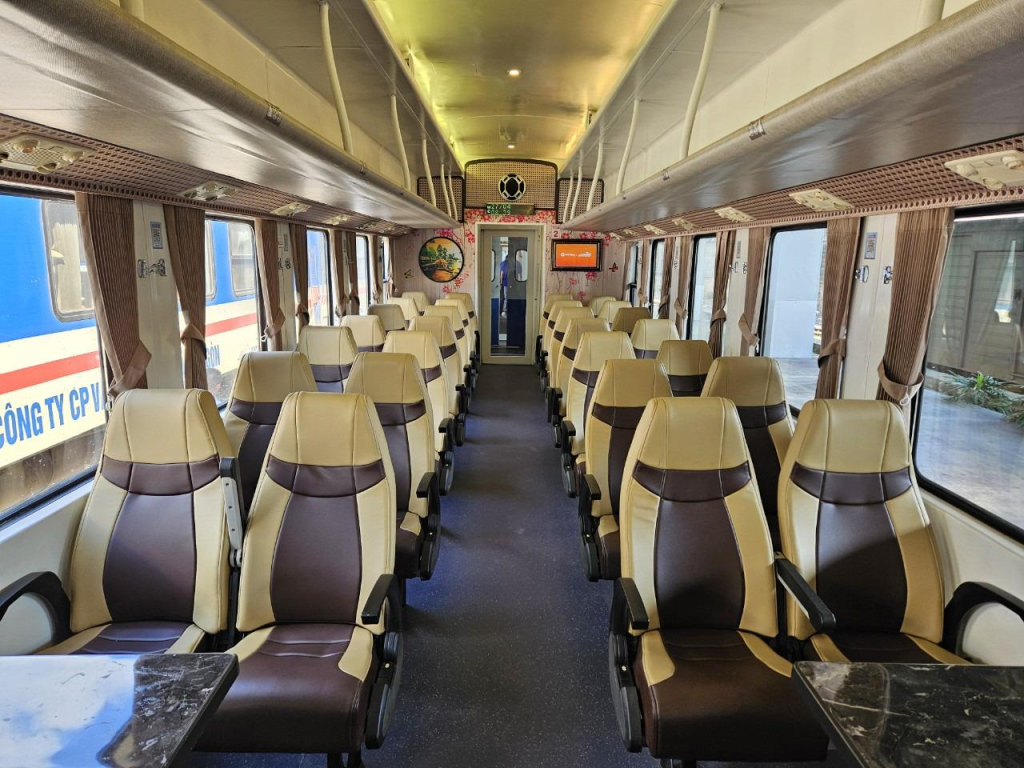
- Soft Seat (Ngồi mềm điều hòa): This is the most popular choice for the Da Nang-Hue journey and generally recommended.
- Description: Carriages with cushioned seats, usually arranged 2×2, with air conditioning. Comfort level is decent, comparable to economy airline seats but often with better legroom.
- Amenities: Shared overhead racks for luggage, sometimes hooks for smaller bags. Power outlets might be available but aren’t guaranteed at every seat. Windows offer views, but cleanliness can be hit-or-miss. Shared toilets at the end of the carriage (cleanliness varies).
- Vibe: A mix of locals and tourists, can be lively.
- Hard Seat (Ngồi cứng): The most basic and cheapest option.
- Description: Wooden benches, often without air conditioning (maybe fans). Not generally recommended for tourists unless you’re on an extremely tight budget and prepared for minimal comfort.
- Amenities: Very basic. Views are possible, but comfort is low.
- Vibe: Primarily locals, can be crowded.
- Soft Sleeper (Nằm mềm điều hòa): Primarily for longer, overnight journeys.
- Description: Compartments with 4 comfortable berths (beds), air-conditioned, with bedding provided (sheet, pillow, blanket). Doors close for privacy.
- Amenities: Small table, reading lights, shared power outlet per cabin. Toilets at the end of the carriage.

- Hard Sleeper (Nằm cứng điều hòa): Also for overnight travel.
- Description: Compartments with 6 berths (3 bunks high), air-conditioned, basic bedding. Slightly less comfortable/private than soft sleepers.
- Amenities: Similar to soft sleeper, but with 6 people sharing the space.
General Onboard Amenities (Regular Trains):
- Toilets: Located at the end of each carriage. Usually a mix of squat and Western-style, cleanliness varies greatly depending on the train and how far into the journey it is. Bring your own toilet paper and hand sanitizer!
- Food & Drink: Food carts regularly patrol the aisles selling instant noodles, rice porridge (cháo), packaged snacks, coffee, beer, and soft drinks. Prices are reasonable. Quality is basic but usually edible. You can also buy food at stations during longer stops (not really applicable for Da Nang-Hue). Bringing your own snacks and water is always a good idea.
- Cleanliness: Can be variable. Newer SE trains are generally better maintained than older TN trains. Floors might not be spotless, and toilets can get messy. It’s part of the experience!
Overall, the regular train offers a functional, authentic slice of Vietnamese travel. Choose a Soft Seat for the best balance of comfort and value on the Da Nang-Hue leg.
The Journey Itself: Hai Van Pass & Scenery
Okay, regardless of whether you choose the slick tourist train or the classic regular train, the undisputed star of the show is the **Hai Van Pass (Đèo Hải Vân)**. This legendary stretch of railway, climbing high above the coastline between Da Nang and Hue, is consistently ranked among the world’s most beautiful train journeys. And for good reason!
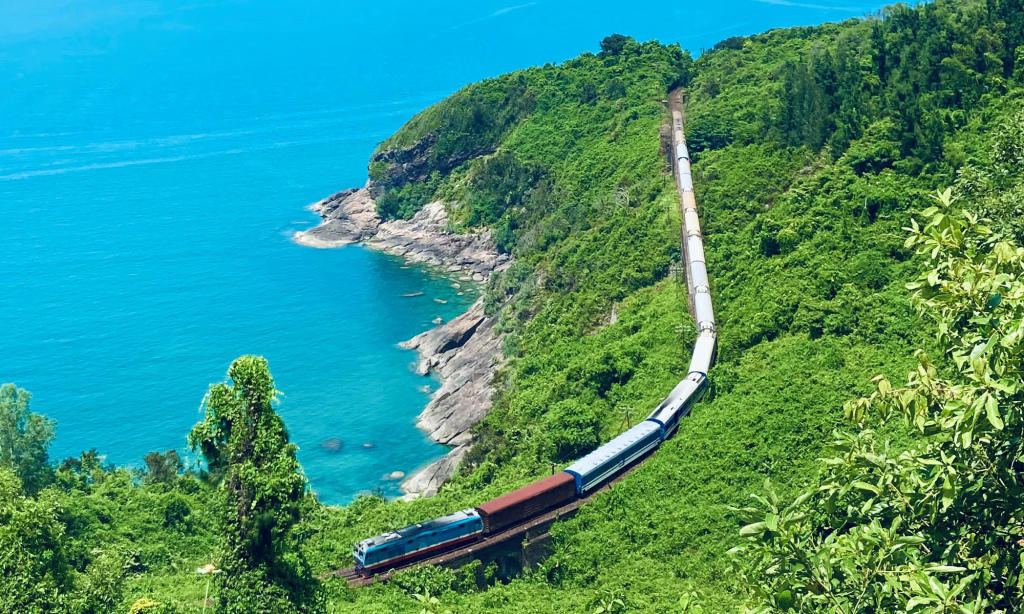
Picture this: As the train pulls away from Da Nang or Hue, it soon begins its ascent. The track clings precariously to the mountainside, revealing increasingly dramatic vistas. On one side, lush green mountains rise steeply. On the other, the track drops away to reveal the turquoise waters of the East Sea, dotted with fishing boats, crashing against rocky cliffs and spilling onto pristine, often deserted, golden sand beaches. You’ll snake through tunnels carved into the rock, emerge to sweeping panoramas, and cross historic bridges. Looking down, you might even see the ribbon of road – the old Hai Van Pass road – winding below.
Practical Information & Tips
Alright, you’ve chosen your train, maybe even booked your ticket. What else do you need to know for a smooth journey? Here are some essential practical tips:

- Da Nang Train Station (Ga Đà Nẵng):
- Location: 200 Hải Phòng, Tân Chính, Thanh Khê, Đà Nẵng. It’s fairly central. (Map Link Placeholder: Link to Google Maps for Da Nang Station)
- Getting There: Easy to reach via Grab (car or bike) or taxi from most parts of the city. Allow maybe 15-20 minutes depending on traffic.
- Facilities: Waiting areas (can be basic), ticket counters, basic toilets, some snack/drink vendors inside and outside.
- Arrival Time: Aim to arrive at least 20-30 minutes before departure to find your platform (usually announced on boards) and carriage.
- Hue Train Station (Ga Huế):
- Location: 02 Bùi Thị Xuân, Phường Đúc, Hue. It’s located slightly southwest of the main tourist citadel area. (Map Link Placeholder: Link to Google Maps for Hue Station)
- Getting to City Center: Plentiful taxis and Grab cars waiting outside. A ride to the main hotel areas near the Perfume River/Citadel should take about 10-15 minutes.
- Facilities: Similar to Da Nang – waiting area, tickets, toilets, some vendors.
- Luggage:
- Official Limits vs Reality: While there are official luggage limits, enforcement is usually relaxed for typical tourist backpacks/suitcases.
- Storage: Use the overhead racks above your seat for backpacks/smaller bags. Larger suitcases usually fit under the seats or in designated luggage areas at the end of carriages (less secure).
- Security: Keep valuables (passport, wallet, electronics) with you in a smaller daypack, not left unattended in large luggage racks. While train theft isn’t rampant, petty crime is possible anywhere.
- Food & Drink Onboard:
- Bring Your Own: Highly recommended to bring a large bottle of water and some snacks you enjoy.
- Onboard Carts (Regular Trains): Offer basic items like noodles, rice porridge, coffee, beer, soft drinks, packaged snacks. Pay in Vietnamese Dong.
- Tourist Train: May include complimentary water/snack. Trolley service for extra purchases available.
- Station Options: Basic kiosks at stations sell drinks and snacks if you arrive early.
- Booking Timing Revisited:
- We can’t stress this enough: Book Ahead! Especially for the tourist train, weekends, holidays (Tet is peak travel time!), and Soft Seats on popular SE trains. Don’t risk showing up hoping for a seat on the day – you might be disappointed or stuck with a less desirable option. A few days to a week in advance is wise for regular times; weeks or even months ahead for Tet.
- Alternatives (Just So You Know):
- While the train offers the best views, other options exist:
- **Bus:** Cheaper, but misses the most dramatic coastal scenery (uses tunnels). Takes about 2-3 hours.
- **Private Car/Taxi:** Most expensive, flexible stops possible, uses the road tunnel mostly.
- **Motorbike:** For the adventurous! Ride the Hai Van Pass road itself for incredible freedom and views (ensure you have experience and proper licensing/IDP).
- **(Subtle Tuan Travel Link):** Companies like Tuan Travel offer reliable private transfers and potentially shuttle bus services in the region, focusing on comfort and reliability if the train schedule doesn’t suit or you prefer door-to-door service, though the train view is unique!
- While the train offers the best views, other options exist:
Conclusion
Well, there you have it – your deep dive into the Da Nang to Hue train journey! It truly is one of Vietnam’s travel highlights, a relatively short trip packed with unforgettable scenery. Whether you opt for the dedicated comfort of the “Connecting Central Heritage” tourist train or the budget-friendly flexibility and local flavour of the regular Reunification Express, you’re in for a treat as you traverse the magnificent Hai Van Pass.
Remember the key takeaways: decide if comfort/experience (Tourist Train) or budget/flexibility (Regular Train) is your priority, always check the latest schedules and prices on the official VNR website (dsvn.vn), book your tickets in advance (especially during peak times!), and snag a seat on the correct side for those epic coastal views (Left Da Nang-Hue, Right Hue-Da Nang). From all of us at Tuan Travel, we believe informed travelers are happy travelers, and we hope this guide helps make your planning smooth and your journey incredible.
So, go ahead, book that ticket, pack your camera, grab a window seat, and prepare to be amazed by one of the most beautiful train rides in the world. Safe travels!
Have you taken the train between Da Nang and Hue? Share your experience or ask any lingering questions in the comments below! We love hearing from fellow travelers.
About the Author / Tuan Travel
This guide was brought to you by the team at Tuan Travel. With years of experience helping international visitors explore the wonders of Central Vietnam, including Da Nang, Hoi An, and Hue, we’re passionate about providing reliable information and quality transport services. While this guide focuses on the train, we also offer dependable shuttle buses, private car transfers, and tours designed for comfort, safety, and showcasing the best of the region. We believe in transparent pricing, clean modern vehicles, professional drivers, and making your travel connections seamless. Visit our main site (Placeholder: Link to Tuan Travel Homepage) to learn more about how we can help with your Central Vietnam adventures!
